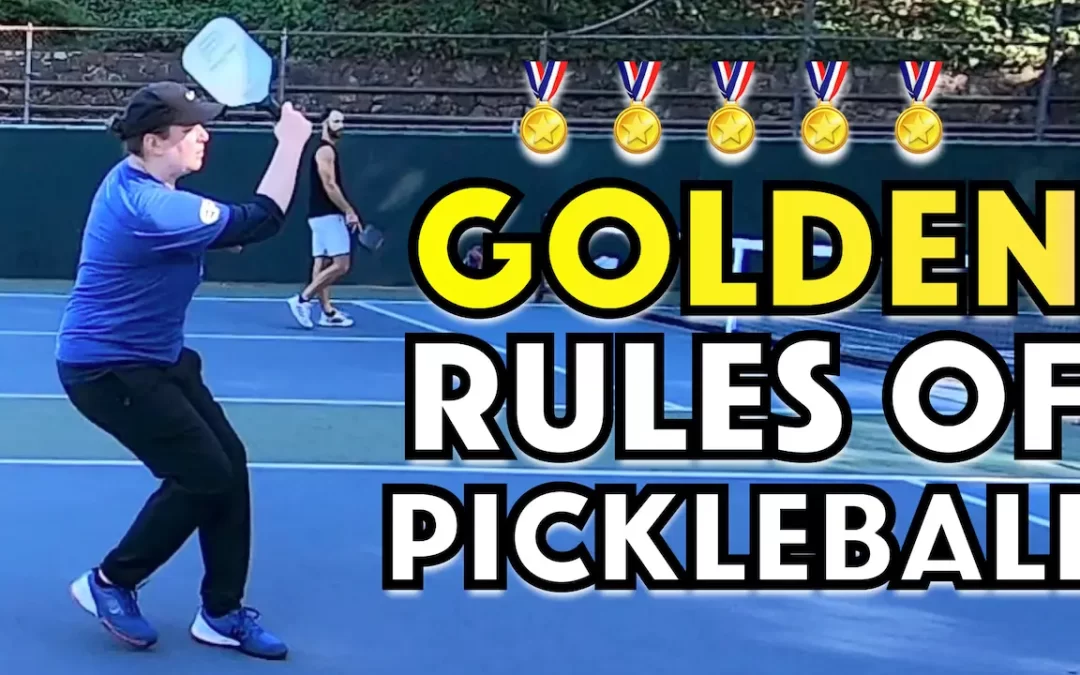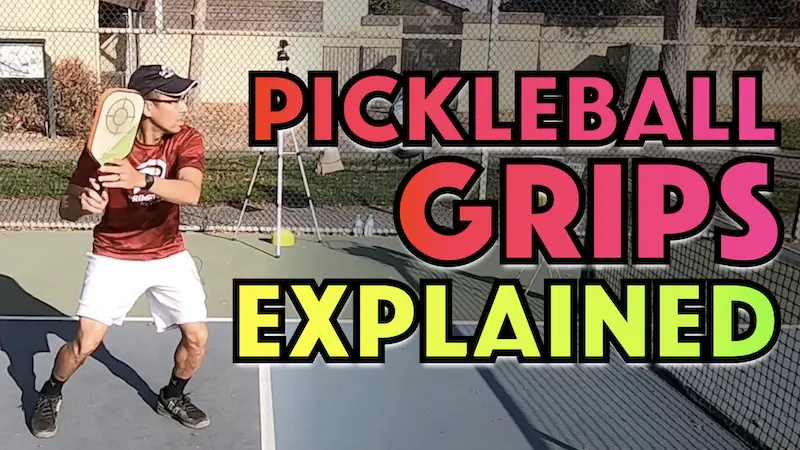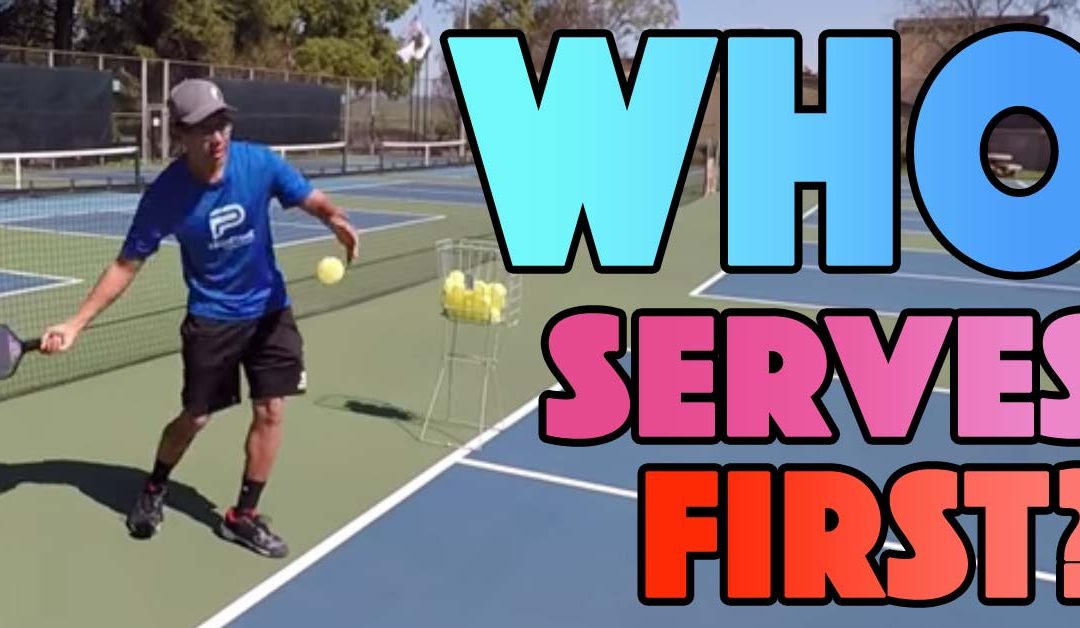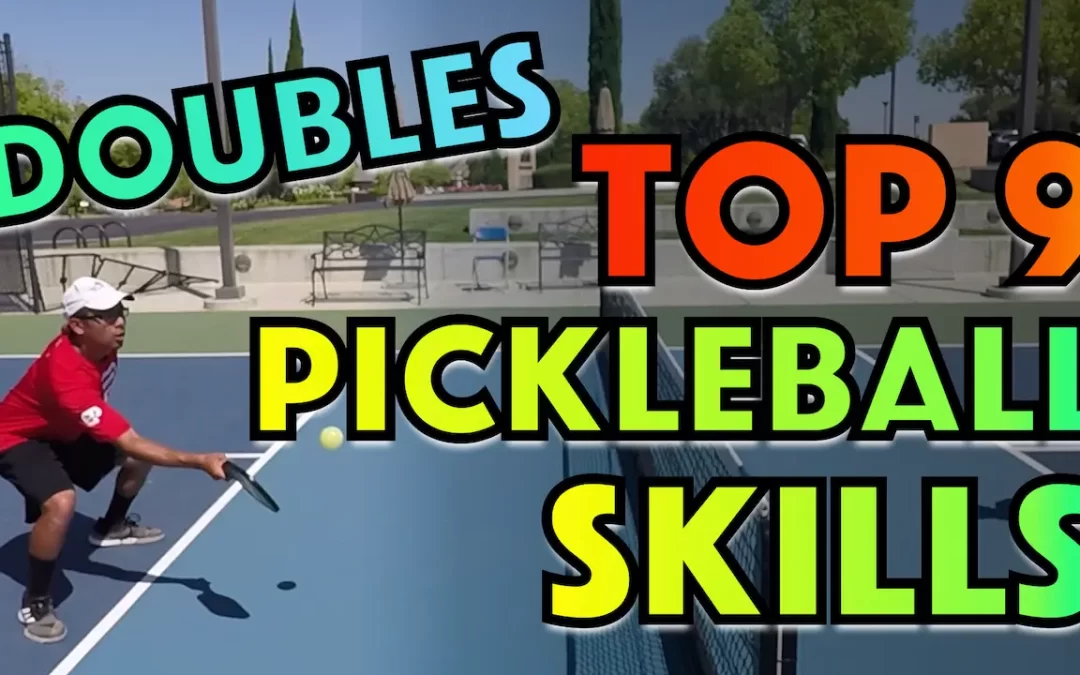The serve is one of the most important aspects of pickleball that you need to master. It’s more than simply getting the ball over the net and into your opponent’s service box.
It can be a powerful tool and you have options to keep your opponent’s guessing and making them hit tough returns.
We’re going to go over seven key serves you can use in your arsenal that can propel you from being a beginner or average server to a great server.
We’re going to break these serves up into categories.
The first three serves are going to be what I call your go-to serves. You’ll use these ones most often because they have the most amount of benefit for you and they can be hit repeatedly with great effect.
They’re your staple serves.
Go To Serves
#1 – Power Drive
The first go-to serve is going to be the power drive. You’re going to hit this one hard and deep.
There will be some natural forward spin on this ball, but your goal is not necessarily to have spin on the ball it’s mainly to hit it very powerfully with as much speed as you can reasonably control and put deep into your opponent’s service box regularly.
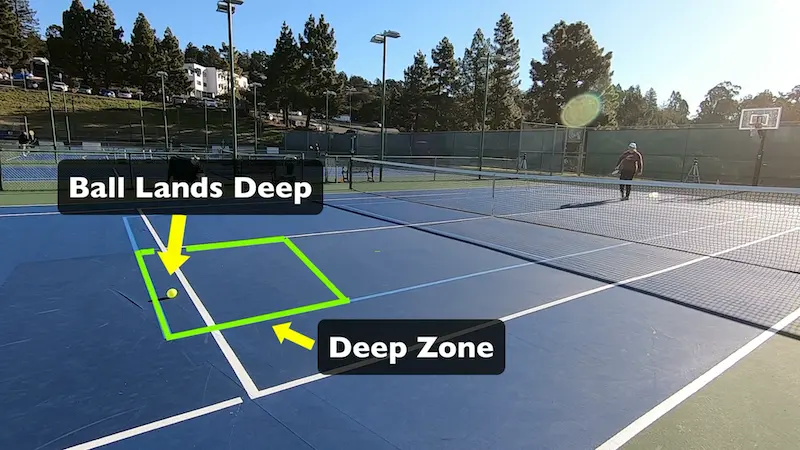
The goal here is to force the returner to hit a very tough return. This serve can achieve that by pushing your opponent as deep in the court as possible.
Hopefully that, in combination with the speed on the ball, will generate a weak return for them.
It’s not guaranteed that they will hit a weak return, but you’ll set it up as well as you possibly can for that to happen.
The more you can do that point after point the more the probabilities stack up in your favour that at least some weak returns will come back.
Also, when you push them back like that, they have a much longer way to go to come into the net and up to the non-volley zone line after their return, so you’ve opened the possibility to keep pressure on them with tough subsequent shots as they approach the net.
As a side note I want to mention that deep is the key and is more important than power.
Power will enhance the effects of your depth, but you can do very well with simply deep drive serves alone. Keep that in mind and don’t be discouraged if you don’t feel you hit the serve very powerfully. Depth rules on the serve.
#2 – Power Topspin
Next up under the go to serves category is the power topspin serve.
If you know how to hit topspin, then this might become your primary go-to serve because it has all the same benefits as the power serve does plus the spin adds an extra layer of complexity for the returner.
After that fast and hard topspin hits the ground, it kicks towards them more and kicks up more than a serve with very little or no spin even if that serve has a lot of power.
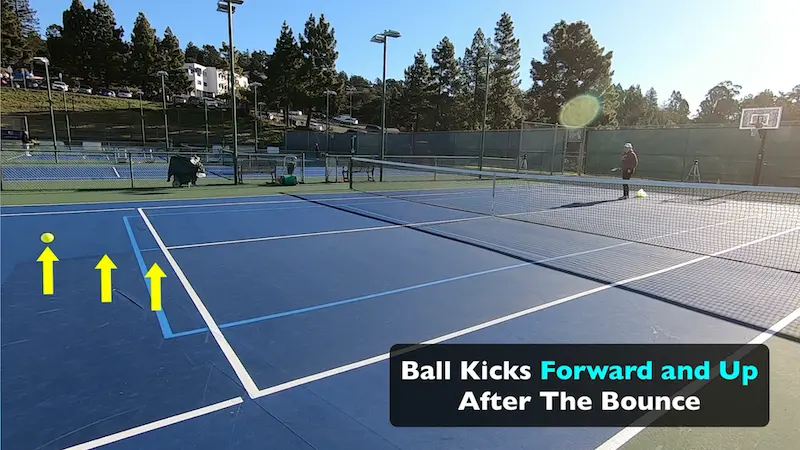
That, in combination with being a deep and fast serve creates more opportunity for opponents to misjudge and therefore mishit their return.
If you’re new to topspin, then watch this video on how to learn to hit topspin.
In pickleball your main goal with the serve is twofold:
#1- You want to cause a shaky return.
#2 – You want to make that trip to the net after they return as difficult as you can.
Power serves are a great option to achieve both goals and you’ll go far if you can master these two serves.
We’ve talked about getting your serves deep because that creates a substantial challenge for the returner. But can you do more when using a power serve? Yes, I’d argue that you can. You can target locations laterally as well.
#3 – Power Serve Targeting A Specific Location
If you notice that your opponent has one side weaker than the other, then you can serve to that side more often with the idea that the coughing up a weaker return on that side is far more likely.
Often, you’ll find that the backhand is a prime target. Many players struggle more with their backhand than their forehands.
It’s not always true so you’ll want to investigate that on each opponent by serving to the other side as well and even send some directly towards them to see how well they get out of the way and create space on serves hit directly towards their body.
That’s a skill that some will have trouble with so investigate what lateral target works well on each returner and go there often.
The backhand is worthy of investigation on many players.
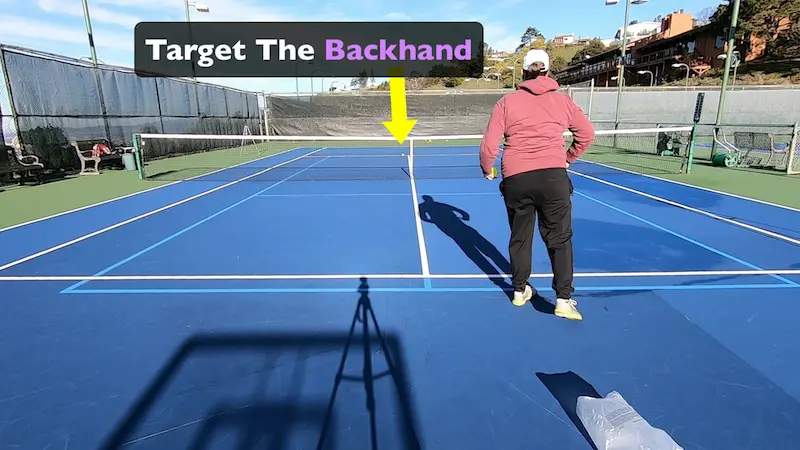
We’ve covered your go-to serves. You’ll use these most often. But now your opponent has been seeing these quite regularly and you may have lulled them into complacency.
Maybe now you find that they’ve adjusted their return starting position to deal with your power and are standing further back as they await your serve.
At this point they’re expecting power and maybe they’ve gotten used to it and are dealing with it better now than they were at the start of the game.
They’re in a rhythm you could say. Well, we don’t really like that.
We want to break the rhythm and that’s what we’re going to do.
These next two serves fall into the mix-up category or the unexpected category.
Mix Up Serves
We’re going to mix things up and shake things up on them and give them a look other than deep power option.
#1 – Lob Serve
Number one for a mix-up serve is the lob serve or you could also think of this as a loft serve since it’s not quite a lob or an off speed and high serve.
You’re going to send them a big rainbow shaped type of serve.
You’ll still want to get it deep because that minimizes the angles they have available to them as far as being able to send you angled shots back that will move you laterally and off the court to one side or the other.
They can generally be less offensive with it when you keep it deep.
Now you’ve given them a different look and hopefully broken their rhythm.They must do a 180-degree adjustment from how they’ve been dealing with the return because it’s totally different than what they’ve been seeing.
It’s basically the total opposite. High and slow instead of low and hard.
It’ll give them time to think and that can lead to bad things such as going for too much on the return and missing.
You’ve achieved a few things with this serve. You’ve shown them that you’re willing to mix things up, so they don’t know what’s coming next.
Ideally you’ve broken up the nice rhythm that they were in. It may cause a miss or a weak return. It may not and that’s okay.
You’ve created some chaos all while still making it so they can’t really do much to hurt you with this return.
It’s an easy serve to hit and it makes things tougher on them in the grand scheme of things.
#2 – Short and Angled Serve
The other mix-up serve you could consider using from time to time is the short and angled serve.
Like the previous serve the best time to use this is when they think a power serve is coming. It’s even better if they have made an adjustment as they await your serve by standing further back.
This serve isn’t as effective if you don’t catch them off guard so keep that in mind.
What you’ll do here is hit short, just beyond the kitchen, and angled, towards the sideline.
Like on the lob serve, this serve will also be on the slower and softer side.
The goal is to get them running forward and off to the side and preferably they’ll have to hit this return while on the full stretch.
You’ll definitely at least give yourself the chance of generating a miss or a weak return.
The returner also must hustle back to get in position for the next shot coming after their return and if they don’t do that well then it creates a gap through the middle that you can exploit and hit through.
Give this one a try but be picky about when you use it because if you don’t use it correctly it doesn’t give the returner much trouble and it just gives them a free trip to the net.
These first five serves we’ve covered today are solid options to go with as far as your total serving plan.
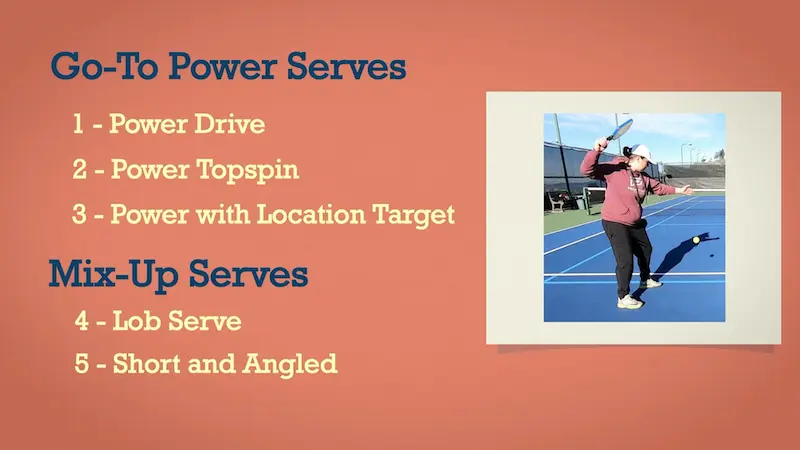
The general idea is to use the power serves most often and mix in the unexpected serves, here and there, to give your opponents a different look.
You’d be in really good shape if you mastered and stuck with just these five serves.
For the most part the pros seem to stick to these five. I suspect it’s because these five serves can all be hit legally out of a traditional serve toss.
The traditional serve toss is when you hit the ball out of the air after releasing it from your hand.
You can get higher contact points out of this toss than you can out of the drop serve toss.
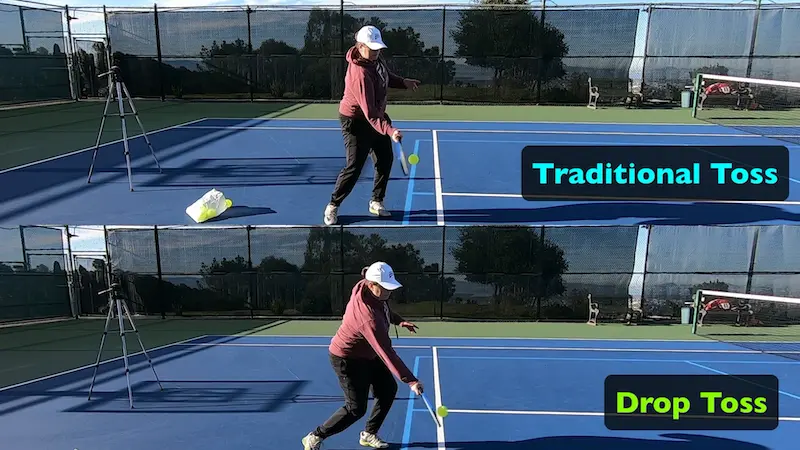
The ball will simply not get up as high after the bounce. Higher contact points make power serves more effective because you can hit more forward and less low to high and still clear the net.
That’s why the traditional toss is often the toss of choice for more advanced players.
I want to add two more serves into the mix for you to consider that are both highly effective and can really create some chaos for your opponents because they’re just so tricky to handle and to time well as the returner.
Drop Serves
Both will need to be done with a drop serve because both require a high to low motion to be effective which is not legal out of a traditional toss.
#1 – Underspin Drop Serve
The first one I’ll cover is the underspin drop serve.
The really nice thing about this serve is that it stays low to the ground when hit well and it’s the under spin on it that causes it to stay low after the bounce.

It’s the total opposite of the topspin serve.
Instead of pressing the returner by kicking towards them, it hits the ground and skids in effect.
On the topspin serve you want them to be late on their contact and the ball hopefully bounces above their ideal strike zone.
In this case you want the ball to skid and bounce below their ideal strike zone causing them to have to stretch and reach down.
#2 – Sidespin Drop Serve
The final serve on our list today is the sidespin drop serve.
This one will bounce and move away from your opponent when hit well and hit towards their backhand side if they’re a righty hopefully causing them to have to stretch and reach for the shot.
Or if you’re hitting it over towards their forehand and you hit it a little closer to them then it will bounce and kick into their body.
So, when you’re going towards their backhand you want to hit it a little bit away because it’s going to bounce away and stretch them and on the forehand, you want to hit it a little closer so that it bends into them.
Just like the other spin serves we’re doing our best to get the ball out of their ideal strike zone and the side spin serve can achieve that.
Notice that the running theme on all these serves is that we’re constantly trying to create chaos with their timing which will impact how good of a return they can hit.
In pickleball you always want to be pressuring your opponents as much as you can with whatever tools you have available to you and these serves can really help you get that done.
Grab a basket of balls get out onto the courts and train up your serves. The beautiful thing about training your serve is that you don’t need a partner to do it you can get out onto the court and get it all done on your own.

